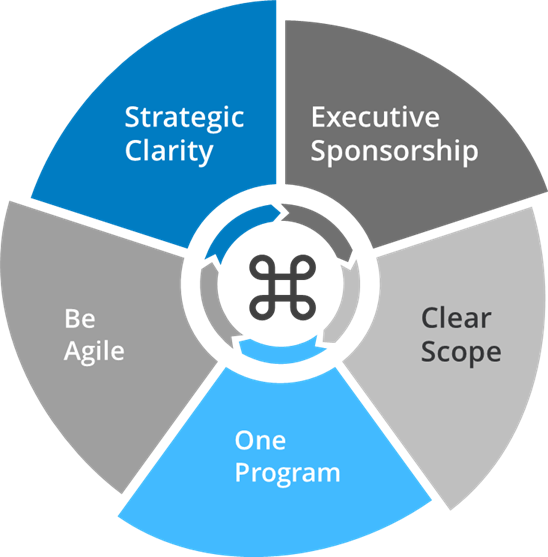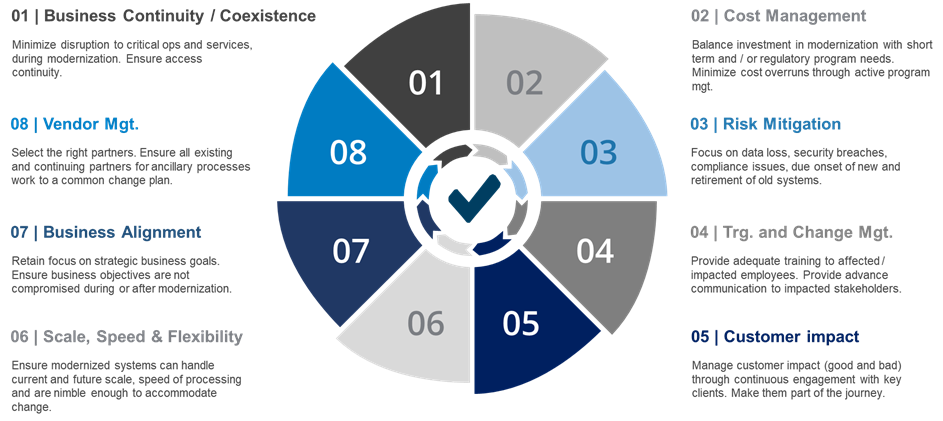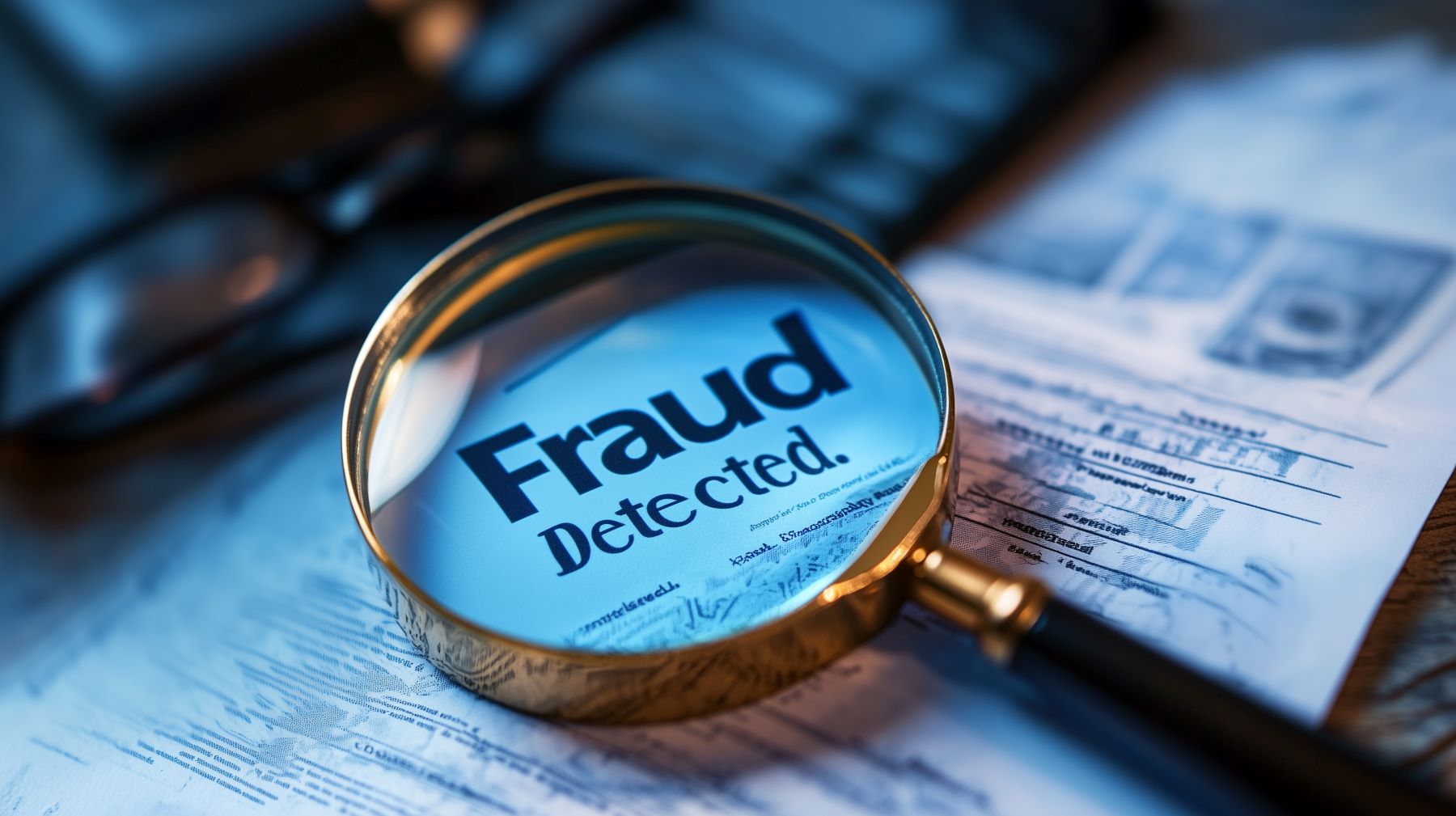What is legacy modernization?
A simple definition is as follows: “Legacy modernization is the process of modernizing legacy systems, often mainframe probably decades old, into modern technologies technically more suited to the needs and wants of modern users and modern processes.”
Note that at its simplest, legacy modernization is replacement of the old with the new. Of course, like all things human or humanly built and operated, actual implementation of a modernization program gets a very complex.
At the highest level, there are aspects such as code change, platform change, experience change, and process change involved.
We look at why modernization needs to be undertaken in the next section. Later in the article, we will also see why despite the best intentions, it may fail, and what can be done to ensure success.
Why legacy modernization?
Legacy modernization is needed because of multiple reasons – some key reasons include:
- Outdated code
- Out of contract systems
- High license costs
- Paucity of trained resources on code due retirements and new resources coming in with new technology skills – Inability of systems to meet current needs of users
- Batch based processes, inability to function in real or near real time basis
- Inability to support Omnichannel experiences
The reasons cited above keep the C-suite awake at night, and therefore, organizations have been taking up modernization programs for a few years now. These initially met with mixed success, but the trend is improving.
Study – Infosys Modernization Radar 2022: The study reveals that 50 percent of the global legacy application landscape is expected to modernize in the next two years, with 70-90 percent modernizing in the next five years.1
2020 Mainframe Modernization Business Barometer Report2: a. “..74% of all respondents admit their organization has started one modernization program but failed to complete it at all – which will have likely come at a significant cost to the business”
2022 Mainframe Modernization Business Barometer Report3: As can be seen from the quote below, programs are gradually starting to succeed. “Upon successful completion of modernization initiatives, the downstream effects reported by survey participants fall into four broad categories: Cost savings, reduced operational and staffing risk, increased agility, and a net positive impact on sustainability.”
How to improve success probability of these programs?
Let’s consider this in two parts.
Tech perspective
The following aspects need to be considered.
- Architectural leadership: Strong architectural leadership with ability to foresee, plan and if necessary, adapt to changing conditions based on new information.
- Cloud adoption: New programs must analyze feasibility of cloud-based solutions based on feasibility, security, scalability and performance.
- Data management: Identify and plan for potential issues to do with data retention, data loss, data integrity, data accessibility, data quality and data migration.
- Security compliance: Implement strong security measures to protect data during and after modernization, including development, testing and production environments.
- Integration capabilities: Ensure ALL legacy connections are identified upfront and notified, plans made for modernization or reconnection & testing, and integration technicalities sorted.
- Scalability and performance: Upfront recognition and planning for current and future scalability and performance needs. Arrive at joint business-technology view on above needs.
- Co-existence: A modernization program will run into years. Adopt robust strategy to ensure existing tech, operations and business units can work in parallel on legacy and modernized systems.
- Optimize tech debt: Ensure there is robust governance around spending decisions during modernization to optimize spend on short term spends (critical only) on legacy tech. Additionally, ensure any change to legacy is also considered through change request mechanisms or otherwise for modernized.
- User experience: Ensure user experience (operations, external clients, business) is either enhanced or is not altered, but at no point becomes sub optimal due to modernization.
- Tech stack: Consider all aspects comprehensively when arriving at the tech stack to ensure smooth working during and after modernization. Be open to change based on feedback from the ground.
Business Perspective
While the overt attention is on the technical aspects of modernization, the following business-related aspects need to be considered to ensure success of the program.
Can Gen AI help?
And if yes, how? The answer to these questions is ‘partially’ in some areas and less so in others.
It is best to look at gen AI in two frames. Where gen AI leads and humans are in the loop, and where humans lead and gen AI is utilized.
Humans in the lead

- For determining the new strategic platform
- For deciding logical sequencing of functionality with an eye on desirability technical feasibility
- For bringing on early adopters among clients
- For ensuring seamless change mgt via clear communication to all stakeholders and managing adverse impacts, if any
Humans in the loop

- For review and guidance
- For training data provision
- For monitoring and bias
- For test data and validation
Seamless Modernization
Is it possible to have seamless modernization? Probably unlikely, but it is possible to approach it with most bases covered by following a well-reasoned strategic approach.

Strategic Clarity
Strategic clarity is primarily about providing a clear direction to the program in terms of its goals. Goals in this case may range from tech stack modernization due obsolescence to business needs being unmet from current tech stack for a variety of factors. However, many goals there are, and there should not be more than four to five, these goals should be agreed at a senior level and percolated to all impacted leads of the organization, so they know what to undertake and what not to, as they go about executing the program. Direction is also in order in terms of go live – whether it should be big bang or phase wise, etc.
Executive Sponsorship
Build senior level sponsorship and accountability for the program to ensure proper governance and guidance. Before a war is fought, the chain of command needs to be established, and yes, even in Agile programs. There will be plenty of times during the execution of the program when there are conflicts between different teams as to who should take up the work, and between conflicting priorities (if the work should be done at this time at all). An executive sponsor with an empowered group will don various roles during program execution including but not limited to providing direction, acting as intermediator, communicating downward, upward and outward to clients.
Clear Scope
Although this does not need to be said, listing clear scope in terms of departments, functions, systems impacted is incredibly important. One also needs to realize, particularly in large transformation programs, is that there will be unknowns coming at you once you start the program. And to sail through these, one needs to be sufficiently stable in foundational scope and requirements (what to do, what not to do) to then be able to respond to increase in scope with a reasoned approach.
One Program, Not Many
Ensure teams work as one program to a common plan and not at cross purposes. Demolish silos. This is easier said than done. Most long running organizations are prone to working in silos where programs are agreed within the divisions and then taken up as per their priorities. This can cause a problem when a large program such as legacy transformation comes along where most if not all units are affected in small or big measure. All department leads should be brought on board by explaining the necessity of the program, its benefits, and its impact to everyone. And since any program will depend on people / SME support, this prioritization is also important for allocating key resource time to the program.
Be Agile
Be open to change as per feedback from the ground. Adapt as feedback is received. Track and update plans as needed, staying within the goals of the program. There may actually be instances where initial architectural direction may show itself to not work on the ground, or for certain regulatory initiatives to come in warranting focus on delivering changes for the reg. programs potentially choosing over the strategic program. A feedback loop with a responsive management is necessary in such cases to take appropriate decisions.
In summary, legacy transformation programs need to be meticulously driven, monitored at all levels from scrum to management teams level, and by a team bringing together expertise in program management, product management, architectural expertise, reverse engineering, delivery, testing, etc. And they should be best be taken up by people who can stay strong on the high seas.












